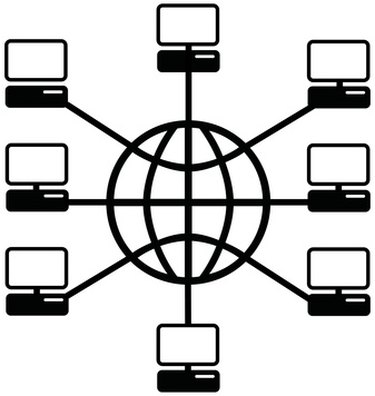
Nowadays, practically every personal computer is connected in one form or another to a network. There exists of course the biggest network of all —the Internet— but several other types of smaller networks like LANs (local area networks) and enterprise networks also exist. Network operating systems (NOS) serve as gatekeepers to data and applications on all manner of these networks. Network operating systems don't differ too much from the single-processor operating systems almost every computer user is familiar with, says Andrew Tannenbaum in his book "A History of Operating Systems", but they have their own unique, fascinating history.
Birth of Networks
Video of the Day
The concept of data communications between computers began in the late 1960s and early 1970s, when researchers began developing a way of connecting computers and exchanging information by way of packets of data. Soon, the concept of a local area network (LAN) took hold, replacing the previous model of a central computing node and so-called "dumb" terminals connected to it, as in IBM's proprietary Systems Network Architecture (SNA) model. The development later on of TCP/IP (Transmission Control Protocol/Internet Protocol) and Ethernet fostered the networking concept even further. The need soon came for operating systems to not only deal with the inter-connectivity of the networks but also the security aspect, according to a research paper from the American University Computing History Museum.
Video of the Day
Arrival of UNIX
During this period, several operating systems were developed, like IBM's MVS operating system, which still dealt with SNA. However, the development of another operating system, dubbed UNIX, really paved the way for NOS everywhere. After a project to develop a large and complex system called Multics failed to get off the ground at Bell Labs in 1969, a group of Bell researchers, led by Ken Thompson and Dennis Ritchie, started work on a less ambitious but no less powerful computing system.
After a rocky first few years, Ritchie developed the C programming language, which allowed UNIX to become the first "portable" operating system, meaning it could be implemented on any computer system. The relative simplicity of the system's design and the availability of its source code turned UNIX into a darling of the academic world and a fixture on many university computer networks. Many versions of UNIX were developed, but the Berkeley Software Distribution (BSD) version, developed in University of California-Berkeley, became arguably the most popular, according to communications powerhouse Alcatel-Lucent.
Netware Makes a Splash
The 1970s also saw the rise of microchips, which ushered in the era of microcomputers and the use of personal computers in the consumer market. Alongside this revolution, a company called Novell became a pioneer in network operating systems with the release of its Netware S-Net device. The product essentially turned the IBM XT, a popular PC at the time that featured a hard drive, into a file-sharing system on which workstations attached to the server in a star-like configuration (hence the "S-Net" name).
Novell also developed its own NOS, also named Netware, for the device. By this time, several competitors came up with their own NOS, but they were all proprietary and only ran on their receptive hardware. In addition, these NOS were built on top of DOS (disk operating system), which was present in practically every IBM PC at that time but was also a single-user, single-tasking system.
Because of its non-DOS-based, multitasking characteristics, as well as Novell's willingness to port its system to a variety of different hardware, Netware soon became the operating system of choice on every major LAN card, according to the Raj Rajagopal's book "Multi-Operating System Networking: Living with Unix, Netware and NT."
The Next Generation of UNIX
Meanwhile, UNIX continued transforming the computer landscape, like when a BSD UNIX computer severed the restrictions of ARPANET, which linked military and university sites, and planted the seeds of what we now know as the Internet. Then in the mid-1980s, a company called Sun Microsystems took UNIX and significantly enhanced its capabilities. The result, dubbed SunOS, added a graphical user interface or GUI, made popular by the introduction of Mac OS and then Windows 3.1 into the consumer market, as well as other features. Solaris, a newer version of SunOS, became even more popular among network administrators.
Microsoft and IBM Team Up
As Novell secured its dominance of the LAN operating system market at that time through its Netware NOS, a company named Microsoft tried to get a feel of where things were going. Early versions of its DOS system featured some network-oriented features, while its MSnet product got the backing of Novell competitors like 3Com, yet to no avail. Incursions into other operating systems such as early versions of Windows were also met with user apathy.
Meanwhile, former minicomputer giant IBM had been seemingly left behind by the LAN revolution and struggled to keep up with Novell. This prompted Microsoft and IBM to team up and develop OS/2, a highly hyped operating system deemed as "the future of personal computing," according to Rajagopal's book. Both companies put all their efforts into dethroning Netware with OS/2, placing it as a priority even over other Microsoft projects like its stumbling Windows system. But with the release of Windows version 3, Microsoft hit the jackpot. As millions of copies of Windows were sold, the industry dynamics changed overnight and plans for OS/2 were forestalled.
Current Players
Nowadays, the major players in the NOS market include Windows, Netware (currently at Version 6.5), and Cisco IOS (stands for "Internetwork Operating System"), as well as UNIX-based operating systems like Linux or one of the many flavors of BSD UNIX.